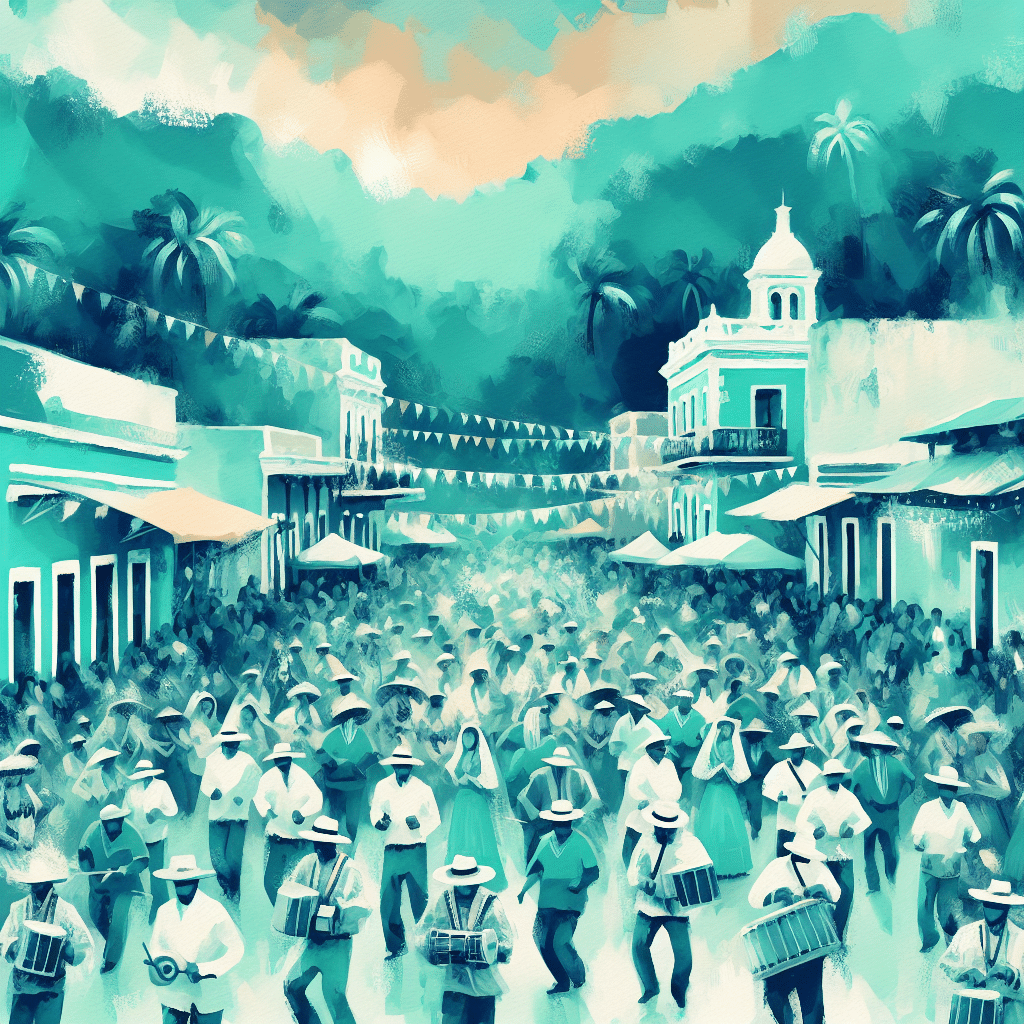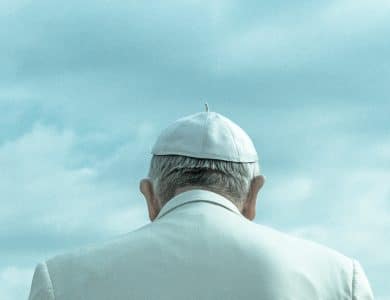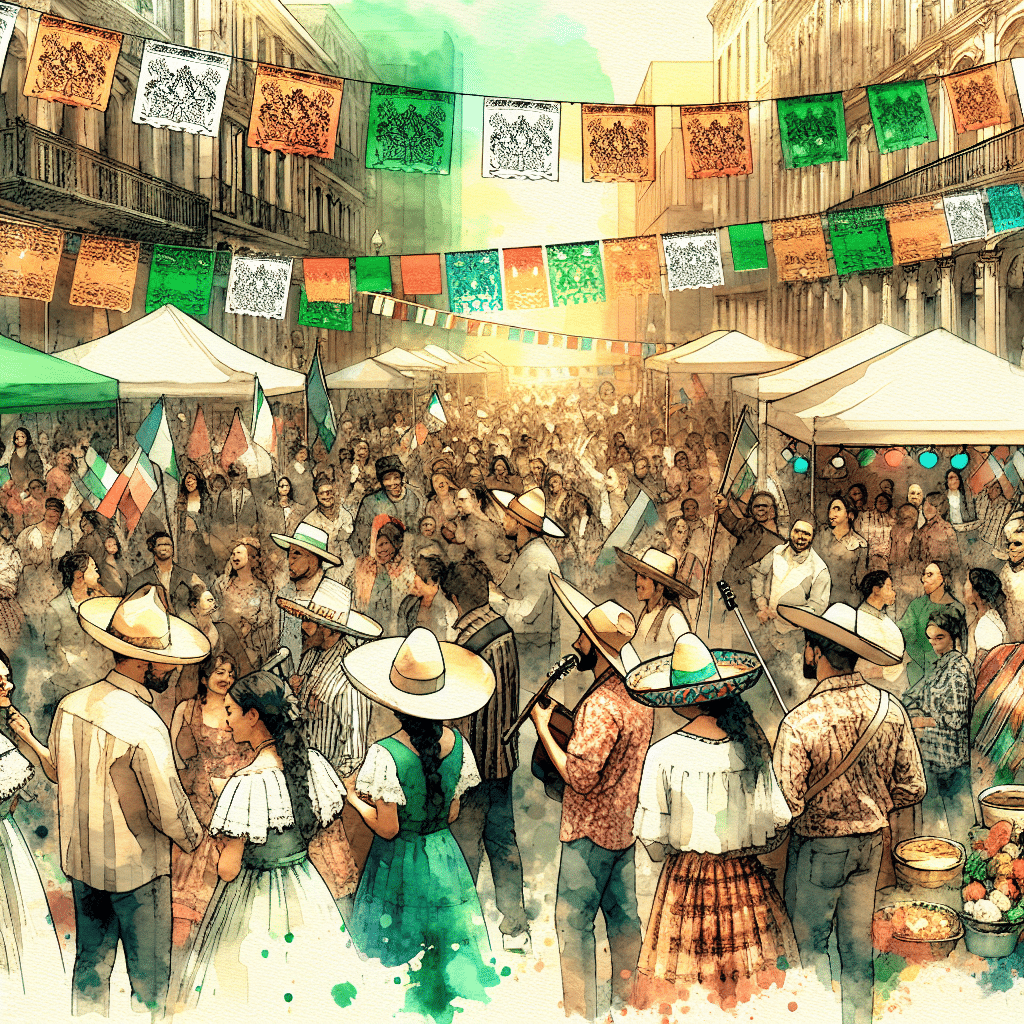
Experience Puerto Rican Festival Traditions: Culture, Music, and Food
Puerto Rican Festival Traditions
Puerto Rican festivals are a lively mix of culture, music, and food. Two of the most loved and eagerly awaited celebrations are Three Kings Day and the San Sebastián Street Festival.
Three Kings Day Celebration
Three Kings Day, or El Día de los Tres Reyes Magos, happens on January 6th. This day celebrates the arrival of the Three Wise Men who brought gifts to baby Jesus. For Puerto Ricans, it’s all about parades, parties, and, of course, gifts. Kids leave grass or hay under their beds for the kings’ camels and wake up to find presents in return.
One of the biggest celebrations is in Juana Díaz, drawing over 25,000 people. The fun continues at Luis Muñoz Marín Park in Old San Juan, where the Three Kings show up, spreading joy to kids and adults alike.
| Event | Location | Attendance |
|---|---|---|
| Main Parade | Juana Díaz | 25,000+ |
| Festivities | Luis Muñoz Marín Park, Old San Juan | Thousands |
For more on the cultural significance and historical background, check out our article on Puerto Rican Religious Celebrations.
San Sebastián Street Festival
Held during the third week of January, the San Sebastián Street Festival, or Fiestas de la Calle San Sebastián, is one of Puerto Rico’s biggest and most iconic parties. This festival marks the end of Puerto Rico’s holiday season and turns Old San Juan into a huge outdoor bash.
The festival has food stalls, arts and crafts, live music, circus acts, and a parade of Cabezudos—giant papier-mâché heads representing characters from Puerto Rican folklore. Starting in 1954 as a religious event for the patron saint of San Juan, it has grown into a colorful celebration of culture and art.
| Feature | Description |
|---|---|
| Food Stalls | A variety of Puerto Rican dishes |
| Arts and Crafts | Local artisans showcase their work |
| Live Music | Performances by local and international artists |
| Cabezudos Parade | Giant heads representing folklore characters |
Join the fun and soak up the lively vibe of this festival. For more on the history and attractions of this event, visit our article on Puerto Rican Festival History.
Both of these festivals showcase Puerto Rico’s rich cultural heritage and vibrant spirit. Whether you’re enjoying the parades of Three Kings Day or the street parties of the San Sebastián Street Festival, you’re in for an unforgettable experience.
Puerto Rican Carnival Fun
When you think of Puerto Rican festivals, the carnival celebrations are the life of the party. Among these, the Ponce Carnival is a standout, bursting with music, costumes, and traditions that make it unforgettable.
Ponce Carnival
The Ponce Carnival, or Carnaval Ponceño, is a week-long bash that kicks off in late February and wraps up on the Tuesday before Ash Wednesday (Puerto Rico Activities). Imagine Mardi Gras, but with a tropical vibe and a lot more salsa!
This carnival is one of the most lively celebrations you’ll find anywhere, featuring traditional bomba and plena music, colorful parades, and the quirky Burial of the Sardine procession, which marks the start of Lent. During this time, Ponce, known as the “Pearl of the South,” turns into a whirlwind of colors, sounds, and flavors.
Here are some highlights:
- Colorful Parades: Floats, dancers, and musicians in eye-popping costumes.
- Vejigantes: These costumed characters wear demon masks, adding a touch of folklore and mystery.
- Masquerade Ball: A fancy event where people wear elaborate masks and costumes.
- Burial of the Sardine: A symbolic event that marks the end of the carnival and the start of Lent.
For more on the history and significance of this event, check out our article on Puerto Rican festival history.
Carnival Music and Vejigantes
Music is the heartbeat of the Ponce Carnival, with traditional bomba and plena tunes setting the stage. Bomba music, with its African roots, features dynamic drumming and call-and-response singing. Plena, often called “the newspaper of the people,” tells stories of everyday life through its lyrics.
But the real showstoppers are the vejigantes. These characters, with their elaborate masks and colorful costumes, represent a mix of Indigenous, Spanish, and African cultures. They play a key role in the carnival’s folklore.
| Feature | Description |
|---|---|
| Vejigantes | Costumed characters with demon masks |
| Music | Bomba and plena |
| Parades | Colorful and lively with floats and dancers |
| Special Event | Burial of the Sardine |
Vejigantes often carry vejigas (bladders) made from cowhide, which they use to playfully bop festival-goers. It’s all in good fun and adds to the carnival’s lively atmosphere. For a closer look at the costumes and characters, visit our section on Puerto Rican festival costumes.
The Ponce Carnival, with its music and characters, captures the spirit of Puerto Rican festival traditions, offering a unique blend of cultural heritage and modern-day fun. If you’re planning to join the festivities, make sure to read more about Puerto Rican festival attractions and Puerto Rican festival highlights.
By getting into the heart of these carnival celebrations, you can truly appreciate the rich cultural tapestry that is Puerto Rico.
Musical Extravaganza
Casals Festival
Picture yourself in a fancy outfit, sipping champagne, and mingling with music lovers in the Caribbean. Welcome to the Casals Festival, an annual classical music celebration honoring the legendary cellist, Pablo Casals. This event usually kicks off in March, turning the San Juan Performing Arts Center into a paradise for classical music fans.
With performances by the Puerto Rico Symphony Orchestra and world-famous musicians, the Casals Festival is a classy affair that would make your high school band teacher beam with pride. It’s more than just a concert; it’s an experience that might make you wish you had some caviar in your pocket. For more on Puerto Rican cultural celebrations, check out our Puerto Rican cultural celebrations.
| Event | Date | Venue |
|---|---|---|
| Casals Festival | March | San Juan Performing Arts Center |
For more about the rich history behind this festival, visit Puerto Rico Activities.
Traditional Bomba and Plena Music
Now, let’s swap the tuxedos for something more laid-back. We’re diving into Bomba and Plena, the heartbeat of Puerto Rican music traditions. Think you can’t dance? Bomba and Plena will change your mind.
Bomba, one of the island’s oldest musical traditions, is like a conversation between the dancer and the drummer. The dancer moves, the drummer responds, and if done right, it’s like watching a live musical improv show. This genre has deep roots in African traditions and is a staple in many Puerto Rican festival traditions.
Plena, on the other hand, is the gossip column of Puerto Rican music. Known as “el periódico cantado” or “the sung newspaper,” Plena songs historically spread news and social commentary. If you think Twitter is fast, try keeping up with a Plena band.
These musical genres shine during events like the Ponce Carnival, a week-long fiesta of music, dancing, and vejigantes (those colorful, masked characters that would give any Halloween costume a run for its money). For more details, visit our article on Puerto Rican festival costumes.
| Music Type | Origin | Key Features |
|---|---|---|
| Bomba | African traditions | Drum and dance interplay |
| Plena | Puerto Rican | Social commentary in song |
For a closer look at these cultural beats, check out Discover Puerto Rico.
By diving into these musical traditions, you not only enjoy the rhythms but also appreciate the rich tapestry of Puerto Rican culture. Whether it’s the high notes of the Casals Festival or the rhythmic pulse of Bomba and Plena, Puerto Rico’s musical offerings are as diverse as they are captivating.
Culinary Delights
Saborea Puerto Rico Food Festival
Think Puerto Rican festivals are just about music and dance? Think again! The annual Saborea Puerto Rico Food Festival is a food lover’s dream that will have your taste buds doing the cha-cha. Held over a weekend in April or May, this event brings together top chefs from around the globe to cook alongside local culinary geniuses. The result? A mouthwatering mix of traditional Puerto Rican foods and modern culinary masterpieces that will make even the most seasoned foodies swoon (Puerto Rico Activities).
From succulent lechón asado to inventive dishes that push the boundaries of Puerto Rican cuisine, Saborea Puerto Rico is a must-attend for anyone who loves food. And let’s not forget the drinks! Whether you’re into local rum, beer, wine, or fancy cocktails, this festival has it all.
Traditional and Modern Puerto Rican Cuisine
Puerto Rican cuisine is a tasty blend of Spanish, African, and Taino Indian influences, creating a culinary experience that’s both rich and varied. If you think Puerto Rican food is just arroz con gandules and lechón asado, think again. These classic dishes are just the beginning.
| Traditional Dish | Description |
|---|---|
| Lechón Asado | Roast pork, often served during holidays and festivals |
| Arroz con Gandules | Rice with pigeon peas, a staple in Puerto Rican cuisine |
| Pasteles | Similar to tamales, made with green bananas, filled with meat |
| Tembleque | Coconut pudding, a popular dessert |
| Coquito | A coconut-based thick drink, similar to eggnog, served during holidays |
Figures courtesy Discover Puerto Rico
But Puerto Rican cuisine isn’t just about tradition. Modern Puerto Rican chefs are shaking things up, blending old and new to create innovative dishes that stay true to their roots. Imagine a classic arroz con gandules with a gourmet twist or a lechón asado slow-cooked to perfection using modern techniques. This mix of the old and the new makes Puerto Rican cuisine so exciting and delicious.
For those wanting to dive deeper into Puerto Rican cuisine, a visit to the Saborea Puerto Rico Food Festival is a must. And if you want to explore more about Puerto Rican festival traditions, check out our article on Puerto Rican cultural celebrations. Whether you’re a traditionalist or a foodie adventurer, Puerto Rican cuisine has something for everyone.
Puerto Rico’s Cultural Melting Pot
Puerto Rico’s culture is a lively mix of indigenous, Spanish, and African traditions. This unique blend shines through in the island’s festivals, art, and music, creating a colorful tapestry of old and new.
Indigenous, Spanish, and African Roots
Puerto Rican culture is a rich stew of its history, with flavors from the Taíno people, Spanish colonizers, and African slaves. These diverse elements come together to create the vibrant cultural heritage seen in modern Puerto Rican festivals.
Indigenous Influence: The Taíno people, the original inhabitants of Puerto Rico, have left a lasting mark on the island’s culture. Their influence can be seen in traditional crafts, food, and even some festival rituals.
Spanish Influence: Spanish colonization brought Catholicism, which plays a big role in many Puerto Rican religious celebrations, like Three Kings Day and Christmas festivities. Spanish language and architecture also prominently feature in Puerto Rican culture.
African Influence: The African heritage is most visible in the island’s music and dance. Genres like Bomba and Plena, celebrated during various festivals, reflect the rhythms and traditions of African slaves brought to the island. Bomba dancing, in particular, is highlighted as one of Puerto Rico’s deepest cultural traditions (Discover Puerto Rico).
Festivals and Art: A Cultural Fiesta
Puerto Rico’s festivals are a spectacular display of this cultural fusion. The island hosts numerous events throughout the year, each celebrating different aspects of its heritage.
| Festival | Cultural Influence | Main Attractions |
|---|---|---|
| Three Kings Day | Spanish | Parades, gifts, and traditional food |
| San Sebastián Street Festival | Spanish & African | Music, dance, and arts and crafts |
| Ponce Carnival | Spanish & African | Masked vejigantes, music, and parades |
| Casals Festival | Spanish | Classical music performances |
| Festival de Santiago Apóstol | Spanish & African | Parades with vejigantes, Bomba music (Discover Puerto Rico) |
The island’s art scene also reflects this blend. From street murals to gallery exhibitions, Puerto Rican artists draw from their diverse backgrounds to create pieces that tell the story of their heritage. Festivals often feature these artworks, allowing visitors to dive into the island’s rich cultural history. For more on how these traditions blend into festivals, check out our section on Puerto Rican festival history.
Experiencing Puerto Rico’s culture is like stepping into a living history book, where every beat of a drum, every dance step, and every festival celebration carries the legacy of its people. The island’s festivals are not just events; they are vibrant expressions of a culture that thrives on the fusion of its diverse roots, making every celebration a unique experience. For a deeper dive into these celebrations, visit our page on Puerto Rican cultural celebrations.
Year-Round Festivities
In Puerto Rico, there’s always a reason to party. With festivals happening almost every weekend, it’s a non-stop celebration of culture, music, and food. Let’s jump into some of the island’s most lively traditions.
Festivals Every Weekend
If there’s one thing Puerto Ricans know how to do, it’s throw a fiesta. Almost every weekend, there’s a festival or celebration happening somewhere on the island, showcasing the rich Puerto Rican festival traditions (Discover Puerto Rico). From small town events to massive street parties, there’s something for everyone.
| Month | Major Festivals |
|---|---|
| January | Three Kings Day, San Sebastián Street Festival |
| February | Ponce Carnival |
| March | Casals Festival |
| April | Saborea Puerto Rico Food Festival |
| May | Festival de la Novilla |
| June | Festival del Frío |
| July | Santiago Apóstol |
| August | Festival of the Yunque |
| September | Coffee Harvest Festival |
| October | Festival de la Paloma |
| November | Puerto Rican Day Parade |
| December | Christmas Celebrations, Parrandas |
For a full list of fiestas patronales in Puerto Rico, check out our detailed guide.
Celebrating Puerto Rican Culture
Puerto Rico’s festivals are more than just parties; they are a celebration of the island’s rich history and diverse culture. From the indigenous Taino traditions to the vibrant African and Spanish influences, each festival tells a story of the island’s past (VAX Vacation Access).
Take the San Sebastián Street Festival, for example. Held in January, this festival marks the end of Christmas in Puerto Rico. It’s a colorful and loud event that takes over the streets of Old San Juan with music, dancing, and plenty of food (Discover Puerto Rico). For more on this, read about Puerto Rican festival highlights.
Another must-see is the Ponce Carnival in February, where you’ll encounter the whimsical vejigantes, masked figures that dance through the streets to the beat of traditional Puerto Rican music (Medium).
In December, Puerto Ricans celebrate the longest Christmas season in the world, known as La Navidad, lasting 45 days. This period is filled with parrandas (musical street parties) and Nochebuena (Christmas Eve) traditions (VAX Vacation Access). Learn more about these unique customs in our section on Puerto Rican religious celebrations.
With endless festivals, parades, and parties, Puerto Rico truly embodies the spirit of celebration. Whether you’re a local or a visitor, there’s always a reason to join in the fun and experience the island’s vibrant Puerto Rican cultural celebrations.
Holiday Traditions
Puerto Ricans sure know how to throw a holiday bash! From twinkling lights to toe-tapping tunes, the island’s holiday traditions are a vibrant mix of its rich cultural roots. Let’s jump into two of the most beloved traditions: Christmas celebrations and the lively parrandas and Nochebuena festivities.
Christmas Celebrations in Puerto Rico
Christmas in Puerto Rico isn’t just a day; it’s a whole season that stretches around 45 days. Kicking off right after Thanksgiving and rolling through mid-January, this festive period is a feast for the senses (Discover Puerto Rico).
| Activity | Description |
|---|---|
| Start Date | After Thanksgiving |
| End Date | Mid-January |
| Highlight | Fiestas de la Calle San Sebastián |
Puerto Ricans go all out with decorations, music, and, of course, food. Traditional dishes like arroz con gandules, lechón asado, and pasteles are must-haves at Christmas dinners, while coquito—a coconut-based drink—keeps everyone in high spirits (Discover Puerto Rico). For more on these tasty treats, check out our section on Puerto Rican Cuisine.
Parrandas and Nochebuena Tradition
Think Christmas caroling is fun? Wait until you experience a parranda or trulla. This is Puerto Rican caroling with a twist. Picture a group of friends and family armed with instruments like panderos, maracas, and cuatros, going from house to house, surprising residents with joyful music. The tradition involves stopping at each house for snacks and drinks before moving on to the next, with the final house hosting the longest party that often lasts until sunrise (Discover Puerto Rico).
| Element | Description |
|---|---|
| Instruments | Panderos, maracas, güiros, cuatros, guitars |
| Songs | Aguinaldos (traditional Christmas songs) |
| Party Duration | Often until sunrise |
Nochebuena, or Christmas Eve, is often more important than Christmas Day itself for many Puerto Ricans. Families gather for a traditional dinner, exchange gifts, and join in parrandas. Many also attend the midnight mass known as Misa de Gallo to welcome Christmas and celebrate the birth of Jesus (Discover Puerto Rico). For more on the religious aspects, visit our page on Puerto Rican Religious Celebrations.
The holiday season in Puerto Rico is a time of joy, music, and community, blending traditions from Indigenous, Spanish, and African cultures. It’s a festive period that truly captures the spirit of Puerto Rican celebrations. For more info on these festivities, check out our section on Puerto Rican Fiestas Patronales.
Colorful Festivals Across Puerto Rico
Puerto Rican festivals are a wild mix of history, culture, and pure joy. Let’s check out two of these lively celebrations: Festival de la Novilla and the combo of Festival del Frío and Santiago Apóstol.
Festival de la Novilla
The Festival de la Novilla in San Sebastián, Puerto Rico, is where a cow gets its moment to shine. Held on the third weekend of January, this festival is all about celebrating the humble heifer (novilla) with a flair that’s uniquely Puerto Rican (Discover Puerto Rico).
Imagine this: a parade with a cow wearing a crown of flowers, leading the procession through town. This bovine beauty queen is followed by floats showing scenes of country life, live bands, artisans, fried food vendors, and even amusement park rides. It’s a moo-sical extravaganza and a feast for the senses.
| Event | Date | Activities |
|---|---|---|
| Festival de la Novilla | Third weekend of January | Parade, live music, artisans, food vendors, amusement park rides |
For more on Puerto Rican fiestas, check out our detailed guide on Puerto Rican Fiestas Patronales.
Festival del Frío and Santiago Apóstol
Festival del Frío
The Festival del Frío, or the “Festival of the Cold,” takes place in Adjuntas, Puerto Rico. Celebrated in late February, this festival honors the coldest peak in Puerto Rico. It’s a chill event, literally and figuratively, with carnival rides, local artisans, games, food, live music, and family-friendly entertainment.
| Event | Date | Activities |
|---|---|---|
| Festival del Frío | Late February | Carnival rides, artisans, games, food, live music, family entertainment |
Santiago Apóstol
Meanwhile, in Loíza, Puerto Rico, the Festival de Santiago Apóstol is held during the last weekend of July. This festival celebrates the Apostle Saint James with a parade that features vejigantes (traditional folk characters) and Spanish knights battling it out in a symbolic representation of the struggle between good and evil (Discover Puerto Rico).
The celebration includes Bomba music, a traditional folk music with African influence, colorful skirts, and dialogues with drummers. It’s a vibrant display of culture and history that’s sure to dazzle.
| Event | Date | Activities |
|---|---|---|
| Festival de Santiago Apóstol | Last weekend of July | Parade, vejigantes, Spanish knights, Bomba music, colorful dancers |
For more insight into these lively celebrations, head over to our section on Puerto Rican Cultural Celebrations.
With festivals like these, every weekend in Puerto Rico feels like a party. Whether you’re into cows with flower crowns, cold peaks, or epic battles between good and evil, there’s a festival that will make you feel right at home. For a deeper dive into the history and highlights of these celebrations, explore more about Puerto Rican Festival History and Puerto Rican Festival Highlights.




